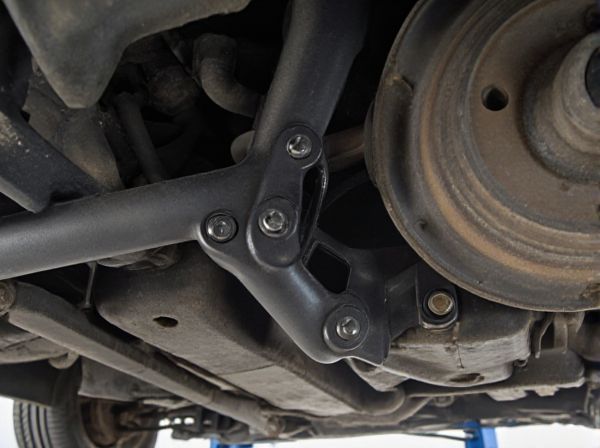
Photo illustration: Gas Strut vs Torsion Bar Hinge
Gas struts provide smooth, controlled motion and adjustable support, making them ideal for applications requiring soft closing and lifting assistance. Torsion bar hinges rely on the torsional resistance of a spring bar to provide leverage, offering a compact and durable solution with consistent force over repeated cycles. Choosing between these mechanisms depends on your specific needs for adjustability, space constraints, and load capacity.
Table of Comparison
| Feature | Gas Strut | Torsion Bar Hinge |
|---|---|---|
| Mechanism | Compressed gas piston for smooth lift | Twisting metal bar providing torsion force |
| Lift Assistance | Strong, controlled support for easy trunk opening | Manual force required, less assistance |
| Durability | Moderate; gas can leak over time, reducing effectiveness | High; metal torsion bars resist wear better |
| Maintenance | Low; mostly sealed unit, replacement needed if fails | Low; simple design with long service life |
| Installation | More complex; requires precise mounting points | Simple; integrated hinge system |
| Cost | Higher initial cost | Lower cost |
| Applications | Common in modern vehicles for smooth operation | Used in older or budget vehicles |
Introduction to Gas Struts and Torsion Bar Hinges
Gas struts provide controlled motion and damping through compressed gas within a cylinder, ideal for smooth lift and support in automotive hoods, cabinet doors, and industrial equipment. Torsion bar hinges use spring steel bars twisted to create torque for door or lid movement, offering robust mechanical assistance without gas or hydraulics. Both components serve as crucial mechanisms for managing weight, motion, and positioning in various engineering applications.
How Gas Struts Work
Gas struts operate using compressed nitrogen gas contained within a cylinder, providing controlled force to assist in lifting and supporting heavy objects like car hoods or cabinet doors. When the strut extends or compresses, the gas pressure adjusts, creating smooth, dampened motion without abrupt movements. This mechanism contrasts with torsion bar hinges, which rely on twisting a metal rod to store mechanical energy, offering different force dynamics and durability.
How Torsion Bar Hinges Function
Torsion bar hinges function by using a twisted metal rod that stores mechanical energy to provide a counterbalancing force, enabling smooth opening and closing of doors or panels. The bar twists under load, creating torque that resists motion, which makes it ideal for applications requiring adjustable tension and durable support. This mechanism contrasts with gas struts that use compressed gas to deliver controlled force, highlighting torsion bars' reliance on elastic deformation for functionality.
Key Differences Between Gas Struts and Torsion Bar Hinges
Gas struts use compressed gas to provide controlled lifting and damping, offering smooth and adjustable motion ideal for applications such as automotive hoods and office chairs. Torsion bar hinges rely on the elastic torsion of a metal bar to exert torque, commonly found in garage doors or industrial equipment where consistent counterbalance is needed. Key differences include gas struts' ability to provide variable force and damping versus torsion bars' fixed spring constant and simpler mechanical design.
Application Scenarios: Where Each Mechanism Excels
Gas struts excel in applications requiring smooth, controlled motion and adjustable force, such as automotive hoods, office chairs, and cabinet doors, where lightweight support and damping are essential. Torsion bar hinges are ideal for heavy-duty scenarios demanding robust torque and longevity, often used in garage doors, industrial machinery, and vehicle suspensions where consistent rotational force and durability under stress are critical. Selecting between gas struts and torsion bar hinges depends on factors like load weight, desired motion control, space constraints, and maintenance preferences in the specific application environment.
Advantages of Gas Struts
Gas struts offer smooth, controlled motion with adjustable damping, enhancing safety and ease of use compared to torsion bar hinges. Their compact design provides space-saving benefits and requires minimal maintenance, making them ideal for automotive, furniture, and industrial applications. The consistent force output of gas struts ensures reliable performance over time, reducing wear and extending product lifespan.
Advantages of Torsion Bar Hinges
Torsion bar hinges provide superior durability and consistent torque control, making them ideal for heavy-duty applications such as automotive hoods and industrial machinery. They offer a compact design that requires minimal maintenance and delivers reliable performance in harsh environments. Unlike gas struts, torsion bars do not rely on pressurized gas, reducing the risk of leaks and prolonging operational lifespan.
Durability and Maintenance Considerations
Gas struts offer superior durability with sealed gas cylinders that resist corrosion and reduce wear, requiring minimal maintenance over time. Torsion bar hinges, while robust and reliable for heavy-duty applications, are prone to metal fatigue and may demand periodic lubrication and tension adjustments to maintain optimal performance. Choosing between the two depends on the specific use case, load requirements, and maintenance capacity, with gas struts favoring low-maintenance longevity and torsion bars excelling in customizable tension control.
Cost Comparison: Gas Strut vs Torsion Bar Hinge
Gas struts typically incur higher initial costs compared to torsion bar hinges due to their complex hydraulic components and precision engineering. Torsion bar hinges, made from durable steel bars, offer a more budget-friendly option with lower upfront expenses and straightforward installation. Over time, gas struts may require maintenance or replacement, potentially increasing long-term costs, while torsion bars often provide a cost-effective, low-maintenance hinge solution.
Choosing the Right Solution for Your Project
Gas struts offer smooth, controlled motion and are ideal for applications requiring soft, dampened lifting or lowering, such as automotive hoods and cabinet doors. Torsion bar hinges provide a robust, compact solution suited for heavy-duty tasks and frequent use, commonly found in industrial machinery and heavy gates. Selecting the right solution depends on factors like load capacity, desired motion control, installation space, and maintenance needs to ensure optimal performance and durability.
 caratoz.com
caratoz.com